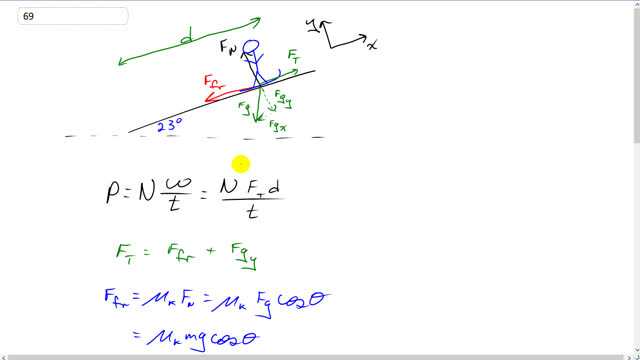
A 65-kg skier grips a moving rope that is powered by an engine and is pulled at constant speed to the top of a hill. The skier is pulled a distance along the incline and it takes 2.0 min to reach the top of the hill. If the coefficient of kinetic friction between the snow and skis is , what horsepower engine is required if 30 such skiers (max) are on the rope at one time?

In order to watch this solution you need to have a subscription.
This is Giancoli Answers with Mr. Dychko. The total power output to tow all these skiers up the hill is gonna be equal to the number of skiers times by the power to pull each one up there. And the work is gonna be the force applied by the tow rope multiplied by the displacement that's parallel to that force. So, the force is gonna be directed up along the slope and so we are gonna take our displacement to also be along the slope. Usually, when we are doing slope questions, we are using vertical height but that is not the case here because there's this friction acting along the slope downwards and there's gravity x-component acting along the slope, downwards. And so the force that we are interested in is doing the work here is this tension force going up along the slope and so let's take the displacement in the same direction. OK So, yeah, we have set up our coordinate system this way, where x-axis is along the slope and and the y-axis is perpendicular to the slope. We know that this tension force or this tow rope force equals the friction going backwards plus the x-component of gravity; we should put an x there, there we go! And I suppose, this arrow should be a little bit longer than the friction force because it has to be a magnitude equal to the total of the friction plus the x-component of gravity. By the way, in this corner there, we have the angle 23 degrees, it's a slope angle there. So, friction force is gonna be the coefficient of kinetic friction multiplied by the normal force and the normal force since there's no acceleration, there's no jumping off the slope or anything, the normal force is gonna equal to the y-component of gravity and that is cosin Θ since it's the adjacent leg of this triangle multiplied by gravity mg. And so the friction force is gonna be µ k times mg cos Θ. And then the x-component of gravity is gonna be mg multiplied by sin Θ so that's mg times sin Θ because this is the opposite leg of that triangle, that's why we are using sin. And substituting each of these into the tow rope force equation, we have force of friction is µ k mg cos Θ plus the x-component of gravity directed down the slope, along the slope mg sin Θ and factoring out the mg just to make these things look cleaner, we have this is the tow rope force. So, the power output is the number of skiers multiplied by this tow rope force times by the distance, or the displacement over which the force acts and then divide by the time that it takes to finish the job. So we have 30 skiers times 65 kilograms per skier times 9.8 newtons per kilogram times the coefficient of kinetic friction of 0.1 times cos 23 plus sin 23 times 320 meters along the slope divided by 2 minutes converted into seconds and so times by 60 seconds per minute and this gives us this number which we multiply by 1 horsepower for every 746 watts, and we get 33 horsepower must be the power output of the engine powering this tow rope.